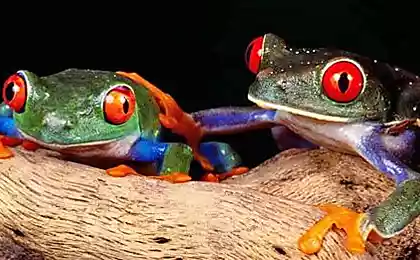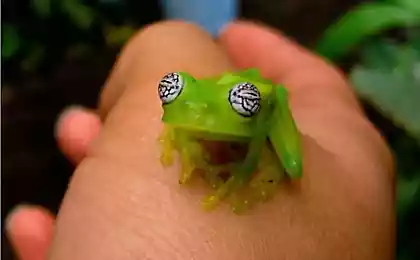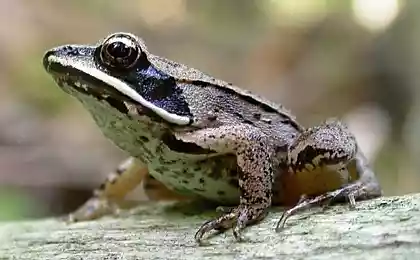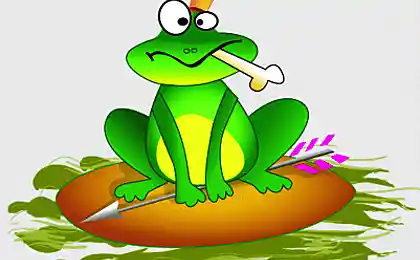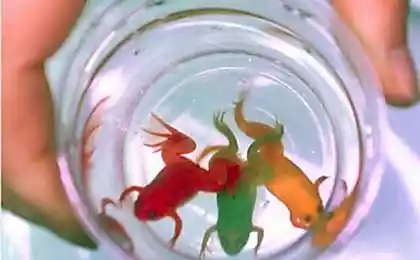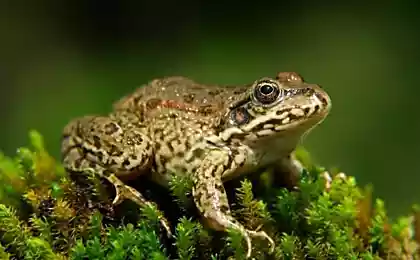251
New species of night frogs discovered in India
For many years, Indian biologists have spent studying the humid rainforests of India, walking kilometers of barely noticeable paths along mountain rivers and swamps, listening to the voices of nocturnal animals and trying to highlight the long-awaited “qua-qua”. And finally, their luck smiled: the researchers were able to find and describe fifteen species of extremely secretive frogs, crawling out of their shelters only at night and during the monsoon season, living in moist soil or along the edges of rapid streams.
The Night Frog (Nyctibatrachus grandis) Photo: Binju Das
Scientists discovered these cheerfully smiling frogs in 2011 in tropical forests at the foot of the Western Ghats. Most of the twelve species of rare semi-aquatic amphibians live in small swamps along the banks of the Indian River Covery in the west of the country. Three other species previously thought to be extinct have been living in the area since the time of the dinosaurs.
The Night Frog (Nyctibatrachus sanctipalustris) Photo: Binju Das
For example, the night frog Kurgus (Latin Nyctibatrachus sanctipalustris), named after the area where it lives, has not been heard for 91 years, and was also considered extinct. The Kurg frog was first described in 1920 by Dr. Narayama Rao, one of the first researchers of amphibians in India. The head of the expedition, biologist Bijou Das from the University of Delhi said that they managed to find only one male of this rare amphibian.
The Night Frog (Nyctibatrachus grandis) Photo: Binju Das
Another interesting species was discovered in the district of Wayanad and received the same name. The night frog Wayanad (Latin Nyctibatrachus grandis) is the largest in its genus: it grows up to 8 cm in length and has a militant character. Unlike its closest relatives, this frog did not throw its clutch with eggs at the first danger, but, gradually increasing in size, tried to bite the aliens by the finger.
The Night Frog (Nyctibatrachus gavi) Photo: Binju Das
Several night frogs Gavi (Latin Nyctibatrachus gavi), loudly singing their songs on the plantations of cardamom, scientists met in the village of Gavi, the Indian state of Kerala. All twelve species are very rare and live in isolated areas of nature reserves, and only the night frog Gavi manages to survive outside protected areas.
The night frog (Nyctibatrachus acanthodermis) Photo: Binju Das
Among the newly discovered species is the nocturnal spike frog (Latin Nyctibatrachus acanthodermis). It got its name due to its thick skin, covered with dense growths that protect it from the sharp claws of predators. The night spiky frog is one of the largest among its relatives: it grows up to 6.5 cm in length, and its habitat is limited to a small patch of rainforest in Kerala.
Meowing night frog (Latin Nyctibatrachus poocha) Photo: Binju Das
Among the found amphibians, no less interest was caused by a frog known as the meowing night frog (Latin Nyctibatrachus poocha). From the local dialect, its name translates as “domestic cat”, since the sounds that scientists heard from it were more like cat meowing than the usual “qua-qua”. Meowing nocturnal frogs live in only two Indian states, lead a secretive lifestyle, hiding in cracks of rocks. They are easy not to notice - these babies grow only 2.5 - 3 cm in length.
Indian scientists hope that their new find will help draw the attention of conservationists not only to such charismatic animals as elephants and tigers, but also to the problems of small modest frogs, which are also on the verge of extinction.
Source: zoopicture.ru
The Night Frog (Nyctibatrachus grandis) Photo: Binju Das
Scientists discovered these cheerfully smiling frogs in 2011 in tropical forests at the foot of the Western Ghats. Most of the twelve species of rare semi-aquatic amphibians live in small swamps along the banks of the Indian River Covery in the west of the country. Three other species previously thought to be extinct have been living in the area since the time of the dinosaurs.
The Night Frog (Nyctibatrachus sanctipalustris) Photo: Binju Das
For example, the night frog Kurgus (Latin Nyctibatrachus sanctipalustris), named after the area where it lives, has not been heard for 91 years, and was also considered extinct. The Kurg frog was first described in 1920 by Dr. Narayama Rao, one of the first researchers of amphibians in India. The head of the expedition, biologist Bijou Das from the University of Delhi said that they managed to find only one male of this rare amphibian.
The Night Frog (Nyctibatrachus grandis) Photo: Binju Das
Another interesting species was discovered in the district of Wayanad and received the same name. The night frog Wayanad (Latin Nyctibatrachus grandis) is the largest in its genus: it grows up to 8 cm in length and has a militant character. Unlike its closest relatives, this frog did not throw its clutch with eggs at the first danger, but, gradually increasing in size, tried to bite the aliens by the finger.
The Night Frog (Nyctibatrachus gavi) Photo: Binju Das
Several night frogs Gavi (Latin Nyctibatrachus gavi), loudly singing their songs on the plantations of cardamom, scientists met in the village of Gavi, the Indian state of Kerala. All twelve species are very rare and live in isolated areas of nature reserves, and only the night frog Gavi manages to survive outside protected areas.
The night frog (Nyctibatrachus acanthodermis) Photo: Binju Das
Among the newly discovered species is the nocturnal spike frog (Latin Nyctibatrachus acanthodermis). It got its name due to its thick skin, covered with dense growths that protect it from the sharp claws of predators. The night spiky frog is one of the largest among its relatives: it grows up to 6.5 cm in length, and its habitat is limited to a small patch of rainforest in Kerala.
Meowing night frog (Latin Nyctibatrachus poocha) Photo: Binju Das
Among the found amphibians, no less interest was caused by a frog known as the meowing night frog (Latin Nyctibatrachus poocha). From the local dialect, its name translates as “domestic cat”, since the sounds that scientists heard from it were more like cat meowing than the usual “qua-qua”. Meowing nocturnal frogs live in only two Indian states, lead a secretive lifestyle, hiding in cracks of rocks. They are easy not to notice - these babies grow only 2.5 - 3 cm in length.
Indian scientists hope that their new find will help draw the attention of conservationists not only to such charismatic animals as elephants and tigers, but also to the problems of small modest frogs, which are also on the verge of extinction.
Source: zoopicture.ru
The bad habits of handling money — how to get rid of them
10 amazing animals with advanced social life
